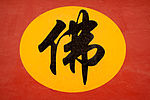|
Kasyapa Matanga
Kasyapa Matanga (Kāśyapa Mātaṇga) or Jia Yemoteng 迦葉摩騰 (Jia Shemoteng 迦攝摩騰, Zhu Yemoteng 竺葉摩騰, or Zhu Shemoteng 竺攝摩騰) was an Indian Buddhist monk who is traditionally believed to have first introduced Buddhism to China in the 1st century CE.[2] According to popular accounts of Chinese Buddhism, Emperor Ming of Han dreamt of a golden deity interpreted as the Buddha and sent a delegation to India. They returned circa 67 CE with the monks Kasyapa Matanga and Dharmaratna, and white horses carrying Buddhist texts and images. The emperor established White Horse Temple in the Han capital Luoyang, where the two supposedly first translated the Sutra of Forty-two Chapters into Chinese.[3] References
|
|||||||||||||||||||||||||||||||||||||||||||||||||||

